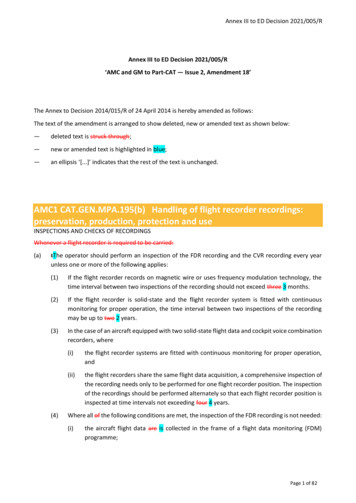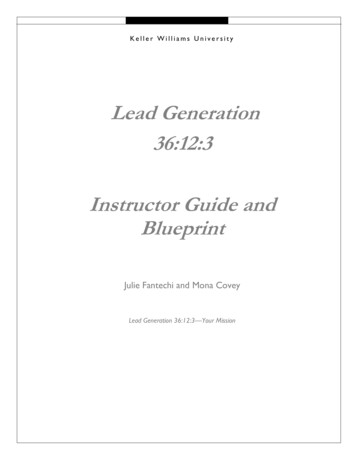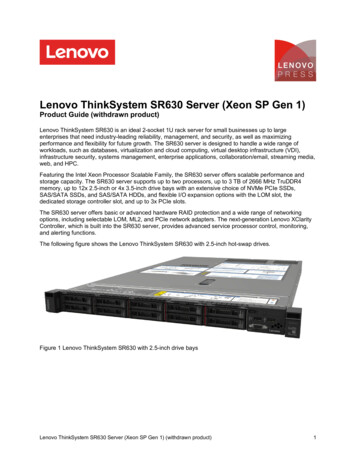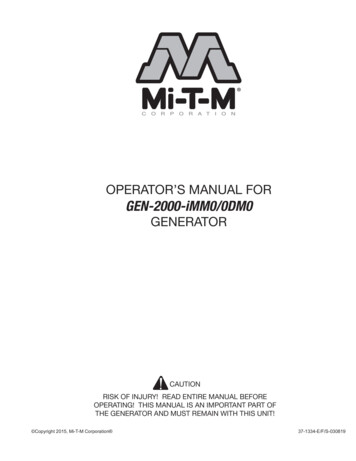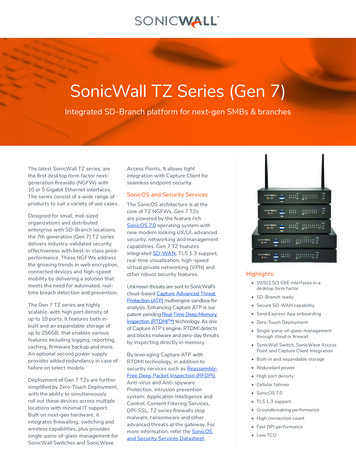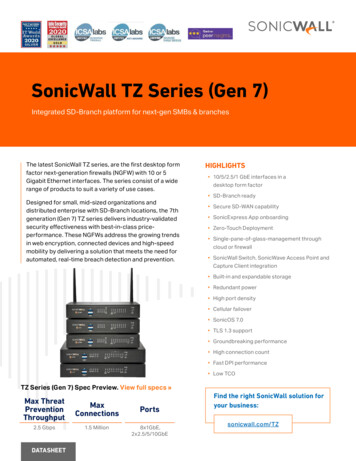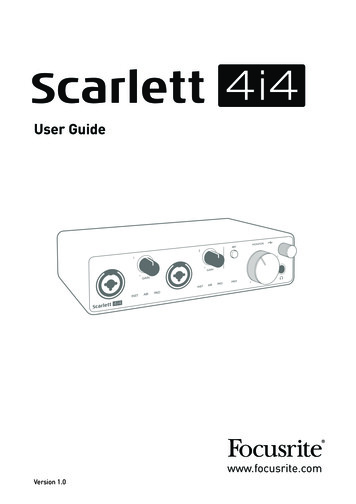
Transcription
User Guidewww.focusrite.comVersion 1.0
TABLE OF CONTENTSOVERVIEW . . . . . . . . . . . . . . . . . . . . . . . . . . . . . . . . . . . . . . . . . . . . . . . . . . . . . . . . . . . . . . . . . . . . . 3Introduction . . . . . . . . . . . . . . . . . . . . . . . . . . . . . . . . . . . . . . . . . . . . . . . . . . . . . . . . . . . . . . . . . 3Features . . . . . . . . . . . . . . . . . . . . . . . . . . . . . . . . . . . . . . . . . . . . . . . . . . . . . . . . . . . . . . . . . . . . 3Box Contents . . . . . . . . . . . . . . . . . . . . . . . . . . . . . . . . . . . . . . . . . . . . . . . . . . . . . . . . . . . . . . . . 4System requirements . . . . . . . . . . . . . . . . . . . . . . . . . . . . . . . . . . . . . . . . . . . . . . . . . . . . . . . . . 4GETTING STARTED . . . . . . . . . . . . . . . . . . . . . . . . . . . . . . . . . . . . . . . . . . . . . . . . . . . . . . . . . . . . . . 5Quick Start Tool . . . . . . . . . . . . . . . . . . . . . . . . . . . . . . . . . . . . . . . . . . . . . . . . . . . . . . . . . . . . . . 5Mac users only . . . . . . . . . . . . . . . . . . . . . . . . . . . . . . . . . . . . . . . . . . . . . . . . . . . . . . . . . . . . . . . . . 5Windows only . . . . . . . . . . . . . . . . . . . . . . . . . . . . . . . . . . . . . . . . . . . . . . . . . . . . . . . . . . . . . . . . . . 7All users . . . . . . . . . . . . . . . . . . . . . . . . . . . . . . . . . . . . . . . . . . . . . . . . . . . . . . . . . . . . . . . . . . . . . . 9Manual Registration . . . . . . . . . . . . . . . . . . . . . . . . . . . . . . . . . . . . . . . . . . . . . . . . . . . . . . . . . . . . 9Audio Setup in your DAW . . . . . . . . . . . . . . . . . . . . . . . . . . . . . . . . . . . . . . . . . . . . . . . . . . . . . 10Loopback Inputs . . . . . . . . . . . . . . . . . . . . . . . . . . . . . . . . . . . . . . . . . . . . . . . . . . . . . . . . . . . . . . 11Examples of Usage . . . . . . . . . . . . . . . . . . . . . . . . . . . . . . . . . . . . . . . . . . . . . . . . . . . . . . . . . . 12Connecting a microphone or instrument . . . . . . . . . . . . . . . . . . . . . . . . . . . . . . . . . . . . . . . . . . 12Using Direct Monitoring . . . . . . . . . . . . . . . . . . . . . . . . . . . . . . . . . . . . . . . . . . . . . . . . . . . . . . . . 13Connecting Scarlett 4i4 to loudspeakers . . . . . . . . . . . . . . . . . . . . . . . . . . . . . . . . . . . . . . . . . . 13Creating an effects loop . . . . . . . . . . . . . . . . . . . . . . . . . . . . . . . . . . . . . . . . . . . . . . . . . . . . . . . . 15Connecting Scarlett 4i4 to a DJ mixer . . . . . . . . . . . . . . . . . . . . . . . . . . . . . . . . . . . . . . . . . . . . . 16HARDWARE FEATURES . . . . . . . . . . . . . . . . . . . . . . . . . . . . . . . . . . . . . . . . . . . . . . . . . . . . . . . . . 17Front Panel . . . . . . . . . . . . . . . . . . . . . . . . . . . . . . . . . . . . . . . . . . . . . . . . . . . . . . . . . . . . . . . . 17Back Panel . . . . . . . . . . . . . . . . . . . . . . . . . . . . . . . . . . . . . . . . . . . . . . . . . . . . . . . . . . . . . . . . 18CHANNEL LISTINGS . . . . . . . . . . . . . . . . . . . . . . . . . . . . . . . . . . . . . . . . . . . . . . . . . . . . . . . . . . . . 19Performance Specifications . . . . . . . . . . . . . . . . . . . . . . . . . . . . . . . . . . . . . . . . . . . . . . . . . . . 19Physical and Electrical Characteristics . . . . . . . . . . . . . . . . . . . . . . . . . . . . . . . . . . . . . . . . . 21TROUBLESHOOTING . . . . . . . . . . . . . . . . . . . . . . . . . . . . . . . . . . . . . . . . . . . . . . . . . . . . . . . . . . . . 22COPYRIGHT AND LEGAL NOTICES . . . . . . . . . . . . . . . . . . . . . . . . . . . . . . . . . . . . . . . . . . . . . . . . 222
OVERVIEWIntroductionThank you for purchasing this Third Generation Scarlett 4i4, one of the family of Focusrite professionalcomputer audio interfaces incorporating high quality Focusrite analogue preamps. You now have asimple and compact solution for routing high quality audio to and from your computer and you willalso be able to download some exciting new software plug-ins once you’ve registered the product.In developing the Third Generation series of Scarlett interfaces, we have made further improvementsto both performance and features. Audio specifications have been upgraded throughout the unit togive you greater dynamic range and even lower noise and distortion; additionally, the mic preamp nowaccepts higher input levels. An important enhancement is the inclusion of Focusrite’s AIR function.Individually selectable on Inputs 1 and 2, AIR subtly modifies the preamp’s frequency response tomodel the sonic characteristics of our classic transformer-based ISA microphone preamps. Whenrecording with good quality microphones, you will notice an enhanced clarity and definition in theimportant mid to high frequency range, just where it is most needed for vocals and many acousticinstruments. Third Generation Scarlett interfaces are class compliant on macOS: this means theyare plug-and-play, so no need to install a driver if you are a Mac user.This User Guide provides a detailed explanation of the hardware to help you achieve a thoroughunderstanding of the product’s operational features. We recommend that both users who are newto computer-based recording, as well as more experienced users, take the time to read through theUser Guide so that you are fully aware of all the possibilities that the Scarlett 4i4 and accompanyingsoftware has to offer. If the main User Guide sections do not provide the information you need, be sureto consult https://support.focusrite.com/, which contains a comprehensive collection of answers tocommon technical support queries.FeaturesThe Scarlett 4i4 hardware interface provides the means for connecting microphones, musicalinstruments or line level audio signals to a computer running Mac OS or Windows. The signals at thephysical inputs can be routed to your audio recording software / digital audio workstation (referredto throughout this User Guide as the “DAW”) at up to 24-bit, 192 kHz resolution; similarly, the DAW’smonitor or recorded output will appear at the unit’s physical outputs.Audio sources – mics, instruments, etc. - connected to the physical inputs can be recorded inthe DAW and then routed from your DAW to the physical outputs. The 4i4 is equipped with fouraudio output channels, which can be connected to an amplifier and speakers, powered monitors,headphones, DJ or other type of analogue mixer, or any other analogue audio equipment that youwish to use. Although all inputs and outputs on the Scarlett 4i4 are routed directly to and fromyour DAW for recording and playback, you can configure the routing within the 4i4’s accompanyingFocusrite Control application in order to meet your needs. The 4i4 also acts as a convenient MIDIinterface between your computer and other MIDI equipment.For DJs, the four analogue outputs make it possible to have a stereo master output and a headphonecue channel when mixing internally on a laptop; alternatively you have two separate stereo outputsat your disposal for connection to an analogue DJ mixer.3
Box ContentsAlong with your Scarlett 4i4 you should find: USB cable, Type ‘A’ to Type ‘C’Getting Started Information (printed on inside of box lid)Important Safety InformationSystem requirementsThe easiest way to check that your computer’s operating system (OS) is compatible with the Scarlett4i4 is to use our online OS Checker at https://customer.focusrite.com/downloads/os. As new OSversions become available over time, you can continue to check for futher compatibility informationby searching our Help Centre at https://support.focusrite.com/hc/en-gb.4
GETTING STARTEDWith the Third Generation, Scarlett interfaces introduce a new, faster way of getting up and running,using the Scarlett Quick Start tool. All you need to do is connect your Scarlett 4i4 to your computer.Once connected, you will see that the device is recognised by your PC or Mac and the Quick Start toolwill guide you through the process from there.IMPORTANT: The Scarlett 4i4 has a single USB 2.0 Type C port (on the rear panel): connectit to your computer using the USB cable provided. Note that Scarlett 4i4 is a USB 2.0 device,and thus the USB connection requires a USB 2.0 compliant port on your computer.The Scarlett 4i4 gets its power from your computer via the USB connection: there is no needfor a separate power supply. However, we do recommend that when using it with a laptop,the laptop should be powered using its AC adaptor, as otherwise the battery will run downfaster than when powering the laptop alone.Your computer will initially treat your Scarlett as a Mass Storage Device (MSD), and during its firstconnection, the Scarlett will be in “MSD Mode”Quick Start ToolWe have tried to make registering your Scarlett 4i4 as simple as possible. The procedure will probablybe self explanatory, but we have described each step below, so you can see how they should appearon either a PC or a Mac.Mac users only:On connecting your Scarlett 4i4 to your Mac, a Scarlett icon will appear on the desktop:5
Double-click on the icon to open the Finder window shown below:Double-click on the “Click Here to Get Started.url” icon. This will redirect you to the Focusritewebsite, where we recommend that you register your device:Click on “Let’s get you started”, and you’ll be presented with a form which will be partly prefilledfor you automatically. On submitting the form, options will be presented to either go straight to thedownloads area to get the software for your Scarlett, or to follow a step by step setup guide basedon your choices. Once you have installed the Focusrite Control software to setup and configure yourinterface, the Scarlett will be switched out of MSD mode so that it no longer appears as a MassStorage Device when connected to your computer.Your OS should automatically switch the computer’s default audio inputs and outputs to the Scarlett4i4. To verify this, go to System Preferences Sound, and ensure that the input and output are setto Scarlett 4i4. For more detailed setup options on a Mac, open Applications Utilities Audio MIDI Setup.6
Windows only:On connecting your Scarlett 4i4 to your PC, a Scarlett icon will appear on the desktop:(Note that the drive letter may be something other than E:, depending on what other devices youhave connected to your PC).Double-click on the pop-up message to open the dialogue box shown below:Double-click on “Open folder to view files”: this will open an Explorer window:7
Double-click “Click Here to Get Started”. This will redirect you to the Focusrite website, where werecommend that you register your device:Click on “Let’s get you started”, and you’ll be presented with a form which will be partly prefilledfor you automatically. On submitting the form, options will be presented to either go straight to thedownloads area to get the software for your Scarlett, or to follow a step-by-step setup guide basedon your choices. Once you have installed the Focusrite Control software to setup and configure yourinterface, the Scarlett will be switched out of MSD mode so that it no longer appears as a MassStorage Device when connected to your computer.Your OS should automatically switch the computer’s default audio inputs and outputs to be theScarlett 4i4. To verify this, right click on the Sound icon on the taskbar and select Sound Settings,and set the Scarlett as the Input and Output Device.8
All users:Note that a second file - “More Info & FAQs” - is also available during the initial set-up process. Thisfile contains some additional information about the Focusrite Quick Start tool which you may findhelpful if you have any issues with the procedure.Once registered, you will have immediate access to the following resources: Focusrite Control (Mac and Windows versions available) - see NOTE belowMulti-language User GuidesLicence codes and links will be provided for the following bundled software within your account page. Pro Tools FirstAbleton Live LiteFocusrite Red 2 & 3 Plug-in SuiteSoftube Time and Tone bundleXLN Addictive KeysPlug-in Collective OffersNOTE: Installing Focusrite Control will also automatically install the correct driver for your device.Focusrite Control is available to download at any time, even without registering: see “ManualRegistration” below.Manual RegistrationIf you decide to register your Scarlet 4i4 at a later date you can do so athttps://customer.focusrite.com/user/register. You will need to enter the Serial Number manually:this number can be found on the base of the interface itself, and also on the barcode label on theside of the box.We recommend that you download and install our Focusrite Control application, as this will disableMSD mode and unlock the full potential of the interface. Initially, when in MSD mode, the interfacewill function at sample rates up to 48 kHz. Once Focusrite Control is installed on your computer, youcan work at sample rates up to 192 kHz. If you decide not to download and install Focusrite Controlimmediately, it can be downloaded at any time ds.In order to force your Scarlett 4i4 out of MSD mode without first registering it, connect it to your hostcomputer and press and hold the 48V button for five seconds. This will ensure that your Scarlett 4i4has full functionality. Please bear in mind that should you wish to register your Scarlett 4i4 aftertaking this action, you will need to so manually, as explained above.9
Audio Setup in your DAWThe Scarlett 4i4 is compatible with any Windows-based DAW that supports ASIO or WDM and anyMac-based DAW that uses Core Audio. After following the Getting Started procedure describedabove, you can start using the Scarlett 4i4 with the DAW of your choice. To allow you to get startedif you do not already have a DAW application installed on your computer, both Pro Tools First andAbleton Live Lite are included; this will be available to you once you’ve registered your Scarlett 4i4. Ifyou need help installing either DAW, please visit our Getting Started pages athttps://focusrite.com/get-started, where Getting Started videos are available.Operating instructions for both Pro Tools First and Ableton Live Lite are beyond the scope of thisUser Guide, but both applications include a full set of Help files. Instructions are also available atwww.avid.com and www.ableton.com respectively.Please note - your DAW may not automatically select the Scarlett 4i4 as its default I/O device. In thiscase, you must manually select Focusrite USB ASIO as the driver on your DAW’s Audio Setup*page. Please refer to your DAW’s documentation (or Help files) if you are unsure where to select theASIO or Core Audio driver. The example below shows the correct configuration in the Ableton LiveLite Preferences panel (Windows version shown).* Typical name. Terminology may differ slightly between DAWs.10
Once the Scarlett 4i4 is set as the preferred Audio Device* in your DAW, Inputs 1 to 4 and Outputs 1 to4 will appear in your DAW’s Audio I/O preferences. Depending on your DAW, you may need to enablecertain inputs or outputs before use. The two examples below show Inputs 1 & 2 and Outputs 1 & 2enabled in the Ableton Lite Audio Preferences.* Typical name. Terminology may differ slightly between DAWs.Loopback InputsYou will notice that two additional inputs - “Inputs 5 & 6” – will be listed on the Input Config pageof your DAW’s I/O Preferences. These are virtual “loopback” inputs within software, not additionalphysical inputs. They can be used to record DAW tracks from sources within your computer, e.g.,from a web browser. Focusrite Control incudes a Loopback 1-2 mix tab, where you can choosewhich inputs to record.Full details of how to use the loopback inputs can be found in the Focusrite Control User Guide.11
Examples of UsageThe Scarlett 4i4 is an excellent choice for several different recording and monitoring applications.Some typical configurations are shown below.Connecting a microphone or instrumentThis setup illustrates the most typical configuration for recording with DAW software on your Mac orPC. In this case, you might record guitar through Input 1 and vocals through Input 2 into your DAW,while monitoring the playback from the DAW via headphones or loudspeakers. Meanwhile, Inputs 3and 4 (on the rear panel) could be connected to any line level source, which we have illustrated in thisexample by a Novation Peak analogue synth.The front panel input sockets are “Combo” type, which accept either an XLR male connector or a ¼”(6.35 mm) jack plug. The full gain range of the microphone preamplifier is only available to a micconnected via the XLR contacts. If your microphone has an XLR plug on the end of the cable, you can12
simply plug it in. If it is a “condenser” (or “capacitor”) microphone, you will need to turn on the 48 voltphantom power for it to work. Most modern microphones of other types, e.g., dynamic or ribbon, willnot be damaged by the inadvertent application of phantom power, but note that some older mics maybe; if you have any doubt, please check the specification of your mic to ensure that it is safe to use.The Scarlett 4i4 has no “Mic/line” switches – the Focusrite preamplifier stages are automaticallyconfigured for a microphone when you plug an XLR into an input, and for a line or instrument when youconnect a jack plug. Select INST from Focusrite Control (‘INST’ illuminates red) if you are connectingmusical instrument, e.g., a guitar in the example, via an ordinary 2-pole guitar jack. Deselect INSTif you are connecting a line level source such as a keyboard, synthesiser or the balanced output ofan external audio mixer via a 3-pole (TRS) jack. Note the Combo connectors accept both TRS and TStypes of jack plug.Input channels 1 and 2 of the Scarlett 4i4 each have a PAD function: when selected from FocusriteControl (PAD illuminates green when active), the signal level fed to your DAW is reduced by 10 dB.You will find this useful if you need to feed the input from a source whose output level is particularly“hot”, when you might notice clipping or the gain halo turning red, even at minimum gain.Using Direct MonitoringYou will probably have heard the term “latency” used in connection with digital audio systems. In thecase of the simple DAW recording application described above, latency is the time it takes for yourinput signals to pass through your computer and audio software, and back to you. While not an issuefor most simple recording situations, under some circumstances, latency can be a problem for aperformer who wishes to record while monitoring their input signals. This might be the case if youneed to increase the size of your DAW’s recording buffer, which could be necessary when you recordoverdubs on a particularly large project using many DAW tracks, software instruments and FX plugins. Common symptoms of a buffer setting that is too low could be glitching audio (clicks and pops),or a particularly high CPU load within your DAW (most DAWs have CPU readouts). If you experiencethis on a Mac, you can raise the buffer size from the DAW application itself but on a Windows PC youwill most likely need to change this from the ASIO Control Panel which can usually be accessed fromyour DAW Setup Preferences*.The Scarlett 4i4, in conjunction with Focusrite Control, allows “zero latency monitoring”, whichovercomes this problem. By using Focusrite Control to monitor your input signals, you will hearyourself in real time along with the computer playback, even with very high buffer sizes. The inputsignals to the computer are not affected in any way by this setting. However, note that the effect ofany plug-ins instantiated in the DAW will not be heard whilst recording because by monitoring in thisway you are hearing the signal before it reaches the software. Also, remember to mute the channelyou are recording to in your DAW otherwise you will hear both the signal you are monitoring and thenthe echo effect of the signal coming back from the DAW.* Typical name. Terminology may differ slightly between DAWs.Connecting Scarlett 4i4 to loudspeakersAny of the Scarlett 4i4’s outputs may be used to connect monitoring speakers. All outputs areelectronically balanced, and available on the rear panel on ¼” (6.35 mm) 3-pole (TRS) jacks.If LINE OUTPUTS 1 and 2 are used for primary monitoring, LINE OUTPUTS 3 and 4 are free to beused for another purpose, such as connecting to an additional recording device or an additional pair13
of monitors. However, please note that only LINE OUTPUTS 1 and 2 are affected in level by the thelarge front panel MONITOR volume control. Also please note that Outputs 3 and 4 are also used tofeed the front panel headphone output.The signals at LINE OUTPUTS 3 and 4 are at (full) fixed level, and thus if you use these for monitoring,you will have to control the volume either from Focusrite Control, or by adjusting the volume at anexternal amplifier.Self-powered monitors (e.g., typical computer speakers) incorporate internal amplifiers with avolume control, and may be connected directly. Larger, passive loudspeakers will require a separatestereo amplifier; in this case, the outputs should be connected to the amplifier’s inputs.Connecting a single pair of active speakersConnecting two pairs of speakersactive and passive)In the setup shown in the lower diagram, a small pair of active monitors connected to Outputs 3 and4 could act as “nearfield” monitors; their volume would either be adjusted locally on the speakers orvia Focusrite Control. The volume of the passive main monitors would be adjusted by the front panelMONITOR control.14
Typical consumer (hi-fi) amplifiers and small powered monitors will have unbalanced inputs, eitheron phono (RCA) sockets, or via a 3.5 mm 3-pole jack plug intended for direct connection to a computer.In either case, use a suitable connecting cable with phono plugs (RCA jacks) at one end.Professional power amplifiers will generally have balanced inputs; we highly recommend usingbalanced cables to connect these to the ¼” jack outputs of the Scarlett 4i4.NOTE: You run the risk of creating an audio feedback loop if loudspeakers are active when youare monitoring a microphone! We recommend that you always turn off (or turn down) monitoringloudspeakers while recording, and use headphones when overdubbing.Creating an effects loopThe Scarlett 4i4 allows the easy integration of external outboard processors or effects. A good exampleis the inclusion of an outboard stereo compressor to a recording setup similar to that outlined above.Connect Line Outputs 3 and 4 to the compressor’s inputs, and the compressor’s outputs to LineInputs 3 and 4, as shown below. We have omitted the front panel connections in this example forclarity.CH 1CH 2INOUTINOUTSee previous example diagramsfor details of connectorsYou can adjust the levels to and from the external processor from Focusrite Control, if necessary.15
Connecting Scarlett 4i4 to a DJ mixerThe Scarlett 4i4 makes an excellent interface between a laptop running DJ software and the channelsof a DJ mixer. In this setup, Outputs 1 and 2 can be connected to Line Inputs 1 and 2 of an externalDJ mixer, and Outputs 3 and 4 to Line Inputs 3 and 4. Connecting in this way means that all mixerfacilities, such as EQs and crossfading, are easily accessible. However, note that you must set thefront panel Monitor Level control to maximum, otherwise Outputs 1 and 2 will be at a lower level thanOutputs 3 and 4.Note that although the outputs of the Scarlett 4i4 are balanced, they may be connected to anunbalanced input using a cable fitted with a ¼” TS jack. Most DJ mixers will have unbalancedinputs using phono (RCA) sockets, so suitable phono-to-TS jack cables will be needed to make theconnection.16
HARDWARE FEATURESFront Panel32145614561110789The Front Panel includes the input connectors for Mic, Line and Instrument signals, as well as theinput gain and monitoring controls.1. Inputs 1 & 2 – “Combo” type input sockets - connect microphones, instruments (e.g.,guitar), or line level signals here. Combo sockets accept both XLR and ¼” (6.35 mm) jacks.Microphones will normally be connected using XLR plugs: instruments and line level signalsshould be connected via ¼” (6.35 mm) jack plugs of either TR or TRS type. The preamp gain isappropriate for microphones when an XLR plug is inserted, and for higher level signals whena jack plug is inserted. Do not connect anything other than a microphone - e.g., the outputof a sound module or FX unit - via an XLR plug, as the signal level will overload the preamp,resulting in distortion; also, if phantom power is enabled, the equipment may be damaged.2. GAIN 1 and GAIN 2 – adjust the preamp gain for signals at inputs 1 and 2 respectively. Thegain controls have concentric tri-colour LED ‘rings’ to confirm signal level: green indicatesan input level of at least -24 dBFS (i.e., ‘signal present’), the ring then turns amber at -6 dBFSto indicate that the signal is close to clipping, and finally to red at 0 dBFS (digital clipping).3. 48V – phantom power switch for mic inputs - enables 48 V phantom power at XLR contacts ofboth Combo connectors.4. INST – two red LEDs; illuminate when Instrument mode is selected for Inputs 1 or 2 fromFocusrite Control; gain is set to suit instrument signals. When INST is off, the ¼” jack input isconfigured to accept a line level signal, e.g., from a keyboard, synth module or FX unit.5. AIR – two yellow LEDs indicating selection of AIR mode for Inputs 1 and 2. AIR mode, selectedfrom Focusrite Control, modifies the frequency response of the input stage to model theclassic, transformer-based Focusrite ISA microphone preamps.6. PAD – two green LEDs; illuminate when PAD is selected from Focusrite Control for Inputs 1or 2. PAD decreases the signal level going to your DAW by 10 dB; use when the input sourcehas a particularly high level.17
7. MONITOR – main monitor volume control, sets the level at rear panel Outputs 1 and 28.Headphone level – adjusts the output level at the front panel stereo headphone output.9.Headphone socket - ¼” TRS output jack – connect your stereo headphones here.10.USB LED – illuminates when the unit receives USB bus power and is confirmed by thecomputer as connected and operating correctly.11. MIDI LED – illuminates when MIDI data is received at the MIDI IN port.Back Panel17 161514131212. LINE INPUTS 3 and 4 – 2 x ¼” TRS jacks; these are balanced inputs for use with additional linelevel sources e.g., from a keyboard, synth module or FX unit.13. LINE OUTPUTS 1 and 2 - 2 x ¼” (6.35 mm) TRS jack sockets, electronically balanced. The levelat these outputs is adjusted by the front panel MONITOR control, the maximum output levelis 10 dBu. Either ¼” TRS (balanced connection) or TS (unbalanced connection) jack plugscan be used.14. LINE OUTPUTS 3 and 4 - 2 x ¼” (6.35 mm) TRS jack sockets, electronically balanced. Thelevel at these outputs may be adjusted from Focusrite Control; the maximum output level is 10 dBu. Either ¼” TRS (balanced connection) or TS (unbalanced connection) jack plugs canbe used.15. MIDI IN and MIDI OUT – standard 5-pin DIN sockets for connection of external MIDI equipmentsuch as keyboards or sound modules. The Scarlett 4i4 provides a convenient MIDI interfacewith your DAW, making a computer MIDI card unnecessary.16.USB 2.0 port – Type C connector; connect to your computer with cable supplied.17. K (Kensington security lock) – secure your Scarlett 4i4 to a suitable structure if desired.18
CHANNEL LISTINGSThe tables below summarise how the Scarlett 4i4’s inputs and outputs will correspond to the inputand output channels in your chosen DAW.4i4 Hardware InputsInput44.1/48 kHz88.2/96 kHz176.4/192 kHzCh 1Input 1Input 1Input 1Ch 2Input 2Input 2Input 2Ch 3Input 3Input 3Input 3Ch 4Input 4Input 4Input 4Ch 5Loopback 1Loopback 1Ch 6Loopback 2Loopback 2Software playback (outputs)Output44.1/48 kHz88.2/96 kHz176.4/192 kHzCh 1Output 1Output 1Output 1Ch 2Output 2Output 2Output 2Ch 3Output 3 (Headphones L)Output 3 (Headphones L)Output 3 (Headphones L)Ch 4Output 4 (Headphones R)Output 4 (Headphones R)Output 4 (Headphones R)SPECIFICATIONSPerformance SpecificationsNOTE: All performance figures measured in accordance with the provisions of AES17, as applicable.Clock SourceInternalSupported sample ratesMicrophone InputsDynamic RangeFrequency Response44.1 kHz, 48 kHz, 88.2 kHz, 96 kHz, 176.4 kHz, 192 kHzTHD NNoise EIN111 dB (A-weighted)20 Hz to 20 kHz 0.1 dB 0.0012% (minimum gain, -1 dBFS input with 22 Hz/22 kHzbandpass filter)-128 dB (A-weighted)Maximum Input Level 9 dBu (no PAD); 16 dBu (PAD selected);measured at minimum gainGain RangeInput impedance56 dB3 kohms19
Line Inputs 1 and 2Dynamic RangeFrequency ResponseTHD NMaximum Input LevelGain RangeInput impedanceInstrument Inputs 1 and 2Dynamic RangeFrequency Response110.5 dB (A-weighted)20 Hz to 20 kHz 0.1 dB 0.002% (minimum gain, -1 dBFS input with 22 Hz/22 kHzbandpass filter) 22 dBu (no PAD); 29.5 dBu (PAD selected);measured at minimum gain56 dB60 kohms110 dB (A-weighted)20 Hz to 20 kHz 0.1 dBTHD N 0.03% (minimum gain, -1 dBFS input with 22 Hz/22 kHzbandpass filter)Maximum Input Level 12.5 dBu (no PAD); 14 dBu (PAD selected); measured atminimum gainGain RangeInput impedanceLine Inputs 3 and 4Dynamic Range56 dB1.5 MohmsFrequency Response20
Operating instructions for both Pro Tools First and Ableton Live Lite are beyond the scope of this User Guide, but both applications include a full set of Help fi les. Instructions are also available at www.avid.com and www.ableton.com respectively. Please note - your DAW may not automat
